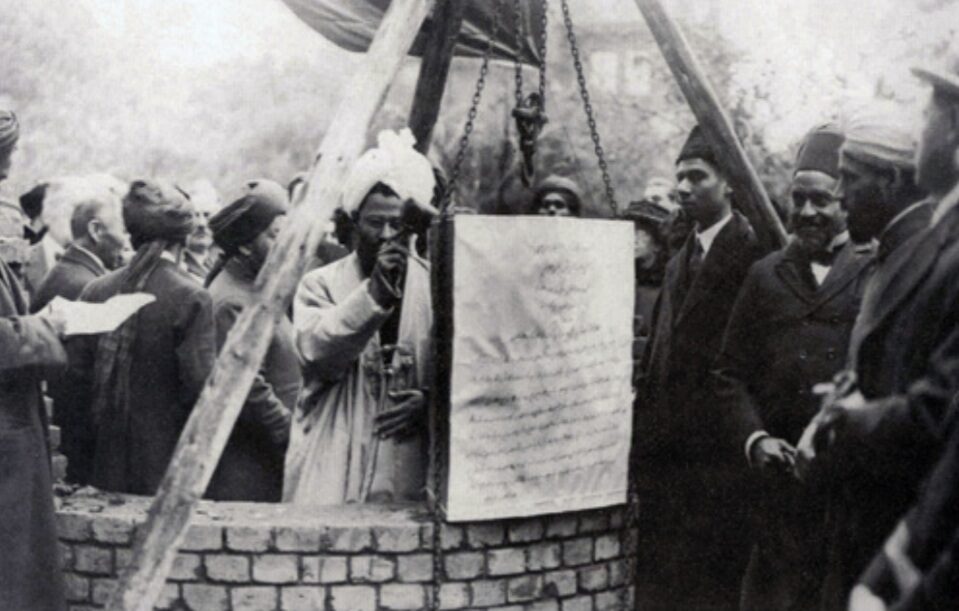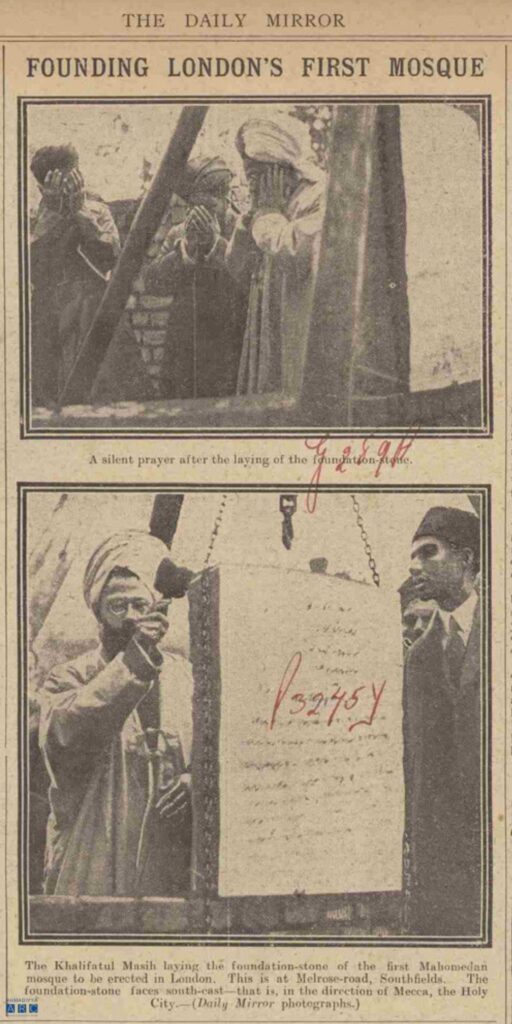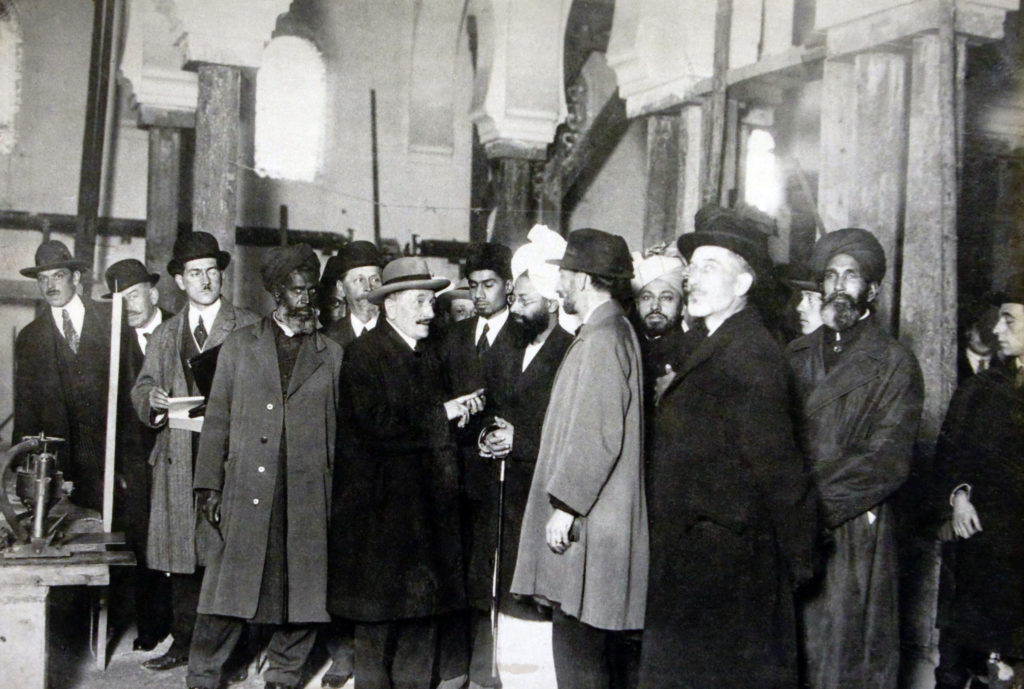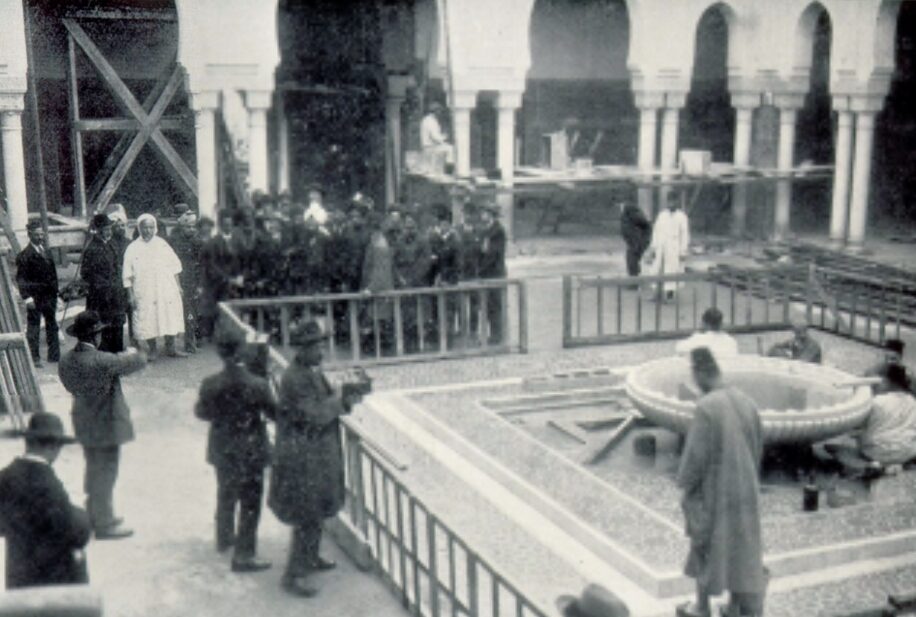Ataul Fatir Tahir, Al Hakam
It seemed never-ending; the continuous opening of mosques and missions worldwide by Hazrat Khalifatul Masih Vaa, prior to the coronavirus pandemic, was witnessed by all. In the last 17 years alone, we have all seen just how fast the Ahmadiyya Jamaat continues to spread, under the wings of Khilafat. The success of this Jamaat is a divine decree and no one can stop it, even though many have tried.
Tahrik-e-Jadid (launched in 1934) has a close connection with building mosques and missions while countering those who aim to put an end to Ahmadiyyat. And so, as the financial year of Tahrik-e-Jadid comes to a close, it is pertinent we reflect upon why we, as a Jamaat, even sacrifice our wealth towards Tahrik-e-Jadid.
The constant inauguration of mosques and missions may seem the norm now, but history has a tougher story to tell. Building mosques and missions across the world – at the rate we see now – was made possible through the continuous sacrifices of Ahmadis towards Tahrik-e-Jadid. After all, it was the Promised Messiahas who said, “The construction of mosques and the advancement of other such endeavours related to Islam depend on financial ability.” (Malfuzat [English translation], Vol. 2, p. 197)
Therefore, in this article, I aim to highlight an important category of Tahrik-e-Jadid: building “mosques in foreign countries”, for the spread of Islam Ahmadiyyat.
A brief background to Tahrik-e-Jadid is vital. In 1929, a novel Muslim political movement called “The Ahrar” was formed in India. This movement began gaining noticeable support when they aimed to “stamp Ahmadiyyat out”; the Ahrar realised the success and unity of the Ahmadiyya Muslim Community, led by Hazrat Mirza Bashiruddin Mahmud Ahmadra who had just had great success fighting the case for Kashmir. Other Ahmadi Muslims were also rising to great prominence, among whom Hazrat Chaudhary Zafrullah Khanra is a prime example. And so, the Ahrar – which consisted of a plethora of Muslim scholars – fuelled a ruthless propaganda campaign in order to declare Ahmadis outside the pale of Islam and to create strong anti- Ahmadiyya rhetoric amongst Muslims in particular. They even established an office in Qadian to create disorder and raise anti-Ahmadiyya opinions in and around Qadian.
In 1934, the Ahrar held their infamous anti-Ahmadiyya conference in Qadian and created great disorder. Observing the boiling of strong anti-Ahmadiyya sentiments, Hazrat Khalifatul Masih IIra initiated a new scheme – through divine intervention – to counteract the hatred and to push Islam Ahmadiyyat forward.

Two salient aims of the scheme were, firstly, for all Ahmadis to focus on moral and spiritual reformation and secondly, to establish Ahmadiyya missions in foreign countries. Hazrat Musleh-e-Maudra pushed back at the anti-Ahmadiyya movements by traversing the borders of India and spreading the Jamaat to every corner of the world – the new scheme was announced in 1934 and was named “Tahrik-e-Jadid”.
Parallels can be immediately drawn with the Holy Prophetsa and the early Muslims who were suppressed so much that the first mosque built by the Prophetsa – Masjid-e-Quba – was not in Mecca, rather outside it, as the Quraish would make it impossible for Muslims to freely practice their religion in Mecca.
In the same vein, Hazrat Musleh-e-Maudra devised Tahrik-e-Jadid so that the Jamaat could spread across the world, even if it was being suppressed in India. Tahrik-e-Jadid had many categories, one such category was to establish “mosques in foreign countries”. Ahmadiyya mission houses would often be accompanied by a mosque – creating a hub for the spread of Islam in the area.
In fact, the Promised Messiahas advised to build mosques for the spread of Islam:
“Right now, our Jamaat is in great need of mosques. It is the house of God. Whatever village or city a mosque of our community is established in, know that the foundation for the success of our Jamaat has been laid [there]. If there is any city or village where Muslims are scarce or do not exist at all and [you] want Islam to spread there, a mosque should be built. Then, God will bring Muslims there Himself.” (Malfuzat [Urdu], Vol. 7, pp. 119-120)
Merely building mosques without a superior intention and purpose has never been the aim of Islam. The Jamaat has always acted upon the following verse of the Quran:
لَمَسۡجِدٌ اُسِّسَ عَلَی التَّقۡوٰی مِنۡ اَوَّلِ یَوۡمٍ اَحَقُّ اَنۡ تَقُوۡمَ فِیۡہِ ؕ فِیۡہِ رِجَالٌ یُّحِبُّوۡنَ اَنۡ یَّتَطَہَّرُوۡا ؕ وَ اللّٰہُ یُحِبُّ الۡمُطَّہِّرِیۡنَ
“… A mosque which was founded upon piety from the [very] first day is surely more worthy that thou shouldst stand [to pray] therein. In it are men who love to become purified, and Allah loves those who purify themselves.” (Surah al- Taubah, Ch.9: V.108)
Emphasising this, the Promised Messiahas continued:
“… However, the condition is that the purpose of establishing a mosque should be sincere; it should be solely for the sake of Allah. There should be no vested interests or evil intentions involved; [only] then will God bless it … the Jamaat should have its own mosque in which there is an imam of its own who delivers lectures, etc. And Jamaat members should gather together and offer Salat in that mosque in congregation. There are huge blessings in community and unison. Being scattered creates disunity. And this is the age in which unity and unison should be greatly increased and trivial matters that cause disunity should be overlooked.” (Malfuzat [Urdu], Vol. 7, pp. 119-120)
Whenever the Jamaat has built mosques, the intent and purpose have always been clear; to create spiritual reformation, act as sanctuaries of peace and bring people towards the peaceful religion of Islam. Hazrat Khalifatul Masih Vaa has expounded on the purpose of mosques at every mosque opening, especially in light of current anti-Muslim sentiments in the West.
Merely constructing large and awe-inspiring mosques just for aesthetics or any other reason has never been the aim of Ahmadi mosques. Our Khulafa have constantly emphasised the spiritual and unifying purpose of a mosque and Hazrat Musleh-e-Maudra would constantly tell Ahmadi Muslims the purpose of building mosques prior to and after the launch of Tahrik-e-Jadid.

Before Tahrik-e-Jadid, the Jamaat was making some progress in establishing missions and mosques outside of India. The foundation stone of the Fazl Mosque in London – the heart of the colonial Empire – was laid in 1924 by Hazrat Musleh-e-Maudra and missions in Indonesia, America and West Africa had been established.

Ahmadi missionaries had also been sent to Iran, Uzbekistan, Damascus, Palestine, Egypt etc. However, following Tahrik-e-Jadid, an intense new wave can be observed in the speed and variety of Ahmadi missions and mosques being established around the world.
Regarding the aim of Tahrik-e-Jadid, Hazrat Khalifatul Masih Vaa has explained:
“Hazrat Musleh-e-Maud’sra purpose for starting Tahrik-e-Jadid was exactly this, that missionaries are prepared to go to foreign countries, open missions there, mosques are constructed and the message of Islam Ahmadiyyat is spread across the world. Once, with great anguish, he said that he desired for mosques to be built in every area of the world, and the earth – in which for a long time, the sound of trinity was being raised – begins to echo with the name of the One God … Our aims will only be achieved when we build mosques in every city, town and village for the propagation of the One God and then fill them with souls that solely worship the One God.” (Friday Sermon, 11 November 2005)
Interestingly, regarding his tour of Europe in 1924, Hazrat Musleh-e-Maudra remarked:
“I am touring Europe so that I may observe the religious condition of Europe with my own eyes and make an accurate assessment to aid me in devising an ongoing scheme for the propagation of Islam in these countries. And my purpose is that I desire to raise the flag of peace in the world; therefore I must observe the elements that bring the East and West together.” (Al Fazl, 29 November 1924)
Certainly, Tahrik-e-Jadid matched “the plan” that Hazrat Musleh-e-Maudra spoke of for spreading Islam and uniting East and West. This desire was in accordance with the divine Will, in which the Promised Messiahas said:
“God Almighty desires to draw all those who live in various habitations of the world, be it Europe or Asia, and who have virtuous natures, to the Unity of God and unite His servants under one Faith. This indeed is the purpose of God for which I have been sent to the world. You, too, therefore should pursue this end, but with kindness, moral probity and fervent prayers.” (The Will [English translation], pp. 8-9)
To enable Islam Ahmadiyyat to spread outside the borders of India effectively, Hazrat Musleh-e-Maudra introduced the “Mosques in foreign lands” category within Tahrik-e-Jadid. Regarding this, he said:
“During this year’s Shura, I launched a scheme for gathering chanda in order to build mosques in foreign countries and that is why [I] gave various suggestions, which, if followed, will enable every person to contribute easily, without any real difficulty … always keep in mind that until we do not build mosques in foreign countries, we will not be successful in conveying the message of Islam there. This is because a mosque acts as the perfect mubaligh [preacher].
“People have forts that are equipped with missiles and guns and they conquer lands with them. However, the forts of Muhammad, the Messenger of Allah, peace and blessings of Allah be upon him, are mosques from where hearts are conquered through the sounds of ‘Allahu-Akbar’ [Allah is the Greatest]. From [the mosques], bombardments of the azan are made day and night which rip through the trenches of disbelief and darkness and bind hearts together.
“People fear worldly forts; even the greatest nations do not let other nations build forts in their country. On the other hand, this fort of Muhammad, the Messenger of Allah, peace and blessings of Allah be upon him, is such that we can easily build it in every country and area and in turn, create the means of propagating Islam. If we do not do this, it will be our own shortcoming.
“Therefore, I appeal to the Jamaat once again that they understand the importance of building mosques in foreign countries and excel in contributing to this fund according to the standard set, so that we are able to rapidly build the forts of Muhammad, the Messenger of Allah, peace and blessings of Allah be upon him …” (Jalsa Salana, 27 December 1952, Tahrik-e-Jadid; Eik ilahi tahrik, p. 303)
Jamaat members responded to this call and began contributing towards building mosques outside of India. At the time, Qadian was the main headquarters of the Jamaat and funded all foreign projects. Interestingly, today, the term “Building mosques in foreign countries” can get confusing as most Jamaats now stand on their own feet, and, for the most part, fund new mosques and missions in their countries independently.
Commenting on the foreign mosques category of Tahrik-e-Jadid, Hazrat Khalifatul Masih Vaa said:
“In this age, in which materialism prevails, it is an Ahmadi who, while spending in the way of Allah, builds His house too and by worshipping Him, tries to beautify himself. For his progeny too, through the highest [spiritual and moral] training, he tries to instil this spirit.
“In this regard, I recall that during our childhood, there used to be a category for foreign mosques within Tahrik-e-Jadid. Every year, when children would pass [their exams], elders would often give them some money during this happy occasion, and [the children] would always donate chanda from this amount towards this category [for foreign mosques] or give it from their pocket money …
“In general, there should be a category for mosques; when children pass [their exams] or at any other joyous occasion, they should give chanda towards building a house of Allah the Almighty. And now, by the grace of Allah the Almighty, all across the world, many Ahmadi children pass their exams. Annually, if auxiliary organisations pay attention to this, and tell them [the children] and the organisation of the Jamaat also tells them, to offer chanda towards this category in celebration of their passing, then where they will be developing a habit of sacrificing wealth towards building a house of Allah the Almighty, they will also be improving their future by gathering the grace of Allah the Almighty [through this act]. Parents should also educate their children regarding this and urge them too. As a result, Allah the Almighty will especially relieve many worries that parents have in this atmosphere.
“May Allah the Almighty also enable us to pray according to the desires of the Promised Messiah, peace be upon him, in the manner that he wanted to mould his Jamaat. And [may we] spread the net of mosques in the East and West and then also fill those mosques with hearts that are full of righteousness. But for this, we too will need to increase our level of worship while seeking forgiveness and repentance.” (Friday Sermon, 11 November 2005)
Through Tahrik-e-Jadid, Jamaat missions and mosques branched out and began spreading, especially to European countries. Often, a mission would be established and then plans for building a mosque would be made.
In 1936 missionaries were sent to Spain, Hungary, Albania and Yugoslavia, and a year later, to Italy and Poland in 1937. (Tarikh-e-Ahmadiyyat, Vol. 11, p. 6)
World War II shocked the world in 1939 and continued until 1945 – during this time, missionaries continued work in foreign lands and established missions while being away from their families. By 1939, Ahmadi missionaries had been sent to Great Britain, Hungary, Poland, Albania, Yugoslavia, Spain, Italy, America, Argentina, Nigeria, Sierra Leone, Ghana, Mauritius, Damascus, Palestine, Indonesia, Burma, Sri Lanka, Japan, Hong Kong and Singapore. (Silsila-e-Ahmadiyya, Vol. II, pp. 15-42)

During the six years of war, Hazrat Musleh-e-Maudra shaped those who gave their lives for Tahrik-e-Jadid into better and more able individuals who had the sole mission to spread the message of Islam Ahmadiyyat.
Following the end of the war, on 18 December 1945, Hazrat Musleh-e-Maudra sent a special group of nine missionaries from Qadian to England for missionary training under the supervision of Hazrat Maulana Jalal-ud-Din Shams Sahib.
Following their field training in England, the new missionaries spread out and established missions in France, Spain, Sicily, Switzerland and Germany. Some of these countries had been sent missionaries earlier, but due to the war, the Jamaat could not establish itself properly.
Every decade saw a continuous rise in new Ahmadi missions and mosques across the world; the list of new missions piled up; Borneo, Holland, Germany, Scotland, Yemen, Muscat, Trinidad and Tobago and Suriname quickly saw the flag of Islam Ahmadiyyat established in their country following the war. (Silsila-e-Ahmadiyya, Vol. I-II)
One can only imagine the financial toll this had and the sacrifices Ahmadis (mostly of meagre means themselves) made towards Tahrik-e-Jadid. These sacrifices continue today, as we hear every year in Huzoor’s Friday Sermon. Hazrat Musleh-e-Maudra would remind Ahmadis of the Jihad they faced and urged them to continue striving for the spread of Islam under Tahrik-e-Jadid:
“This is a jihad; that is why every Ahmadi should take part in it. Try to ensure that there is no Ahmadi left who has not taken part [in Tahrik-e-Jadid]. It is not essential now to increase chanda every year. If your income has lowered then by all means reduce your chanda too, but do not be deprived of taking part.” (Jalsa Salana, 27 December 1952, Tahrik-e-Jadid; Eik ilahi Tahrik, p. 303)
On another occasion, he said:
“Remember that right now, it is you who are carrying out the propagation of faith; there is no one else left other than yourselves [for this task]. You are the only community in the world holding the flag of the religion of God Almighty. You may complain that you are the ones who have been declared as outside the fold of Islam; you are the ones against whom [Muslim] clerics join hands and issue verdicts of kufr [disbelief]; however, this is nothing to complain about. Due to this, the greatness and excellence of your work increases.” (Friday Sermon, 23 January 1953, Tahrik-e-Jadid; Eik ilahi Tahrik, p. 308)
For the early missionaries of Tahrik-e-Jadid, by no means was it a walk in the park. Preaching any set of beliefs and asking people to analyse and challenge their own beliefs is never easy. But travelling to foreign lands and communicating in a foreign language and culture adds to the difficulties they faced. Reports from the missionaries of the time reflect the challenges they faced.
For example, two missionaries of Tahrik-e-Jadid, Malik Ata-ur-Rahman Sahib and Maulvi Ataulllah Sahib were sent to Paris in 1946 to establish a mission. They converted a hotel room into an Ahmadiyya mission. It was a humble beginning and there were many obstacles to overcome. These missionaries reported on how the French did not appreciate their arrival, frowned upon them, showed no hospitality to them and were averse to the message of Islam. (Tarikh-e-Ahmadiyyat, V. 11, p. 14)
They wrote back and reported the harsh and unwelcoming atmosphere to Hazrat Musleh-e-Maudra. Later, during a sitting with Hazrat Musleh-e-Maudra and Jamaat members, regarding the report the missionaries from France sent, Huzoorra remarked that he was already aware of the harsh environment in France and then advised, “… the nation that wants to be successful endures all sorts of pain. And our missionaries went there [to France] with this understanding that they would have to walk on thorns and were actually faced with thorns and they are enduring them for the love of God the Almighty.” (Al Fazl, 4 June 1946)
Interestingly, in 1924, during his visit to France, Hazrat Musleh-e-Maudra was invited to visit the Grande Mosquée de Paris (The Grand Mosque) that was being built by the French government in Paris. Present were prominent newspapers and Muslims who greeted Huzoorra and his entourage.

Hazrat Musleh-e-Maud’sra passion for acquiring mosques and spreading the message of Islam was so much that he led a long prayer in the mihrab of the mosque along with his companions. Hazrat Musleh-e-Maudra later remarked, “I prayed, ‘O Allah, may this mosque be given to us and [may we] be given the opportunity to make it a means of spreading your religion.’” (Al Fazl, 18 December 1934)

The establishment of the Jamaat’s mission in Spain also saw great difficulties. Hazrat Musleh-e-Maudra had a special place in his heart for spreading Islam in Spain. He spoke of how our Muslim ancestors ruled these lands and brought enlightenment through Europe when Spain was under Muslim rule.
In one speech, Huzoorra spoke of the majestic buildings in Granada built by Muslims and the scores of libraries that were present during Muslims rule. Spain was also the gateway to Europe and thus, through tabligh in Spain, the rest of Europe would be easily accessible. To establish an Ahmadi Muslim mission in Spain was something Hazrat Musleh-e-Maudra said he always wanted to do. (Al Fazl, 17 July 1946)
By the grace of Allah, through Tahrik-e-Jadid, two missionaries were sent to Spain to establish a mission in 1947. Due to a change in the financial circumstances of the Jamaat, funding for the Spain mission (and other missions) had to stop, but the missionary, Karam Ilahi Zafar Sahib requested Hazrat Musleh-e-Maudra to allow him to continue work in Spain, even without any stipend from the Jamaat. Many other missionaries in foreign lands made these requests too.
By Allah’s grace and the hard work by Karam Ilahi Zafar Sahib, scores of Spanish people began converting to Islam Ahmadiyyat and the Jamaat gained great prominence in Spain. This reached its climax when the Spanish government had to step in and end Ahmadiyya activity. A government official of Pakistan in Spain called Karam Ilahi Zafar Sahib to his office and said he was told that inviting people to Islam in Spain was declared by the Spanish government as something against the constitution of Spain. Therefore, due to the Jamaat’s missionary activities and its success, the Spanish government put a ban to the spread of Islam in Spain.
Doors for tabligh later opened and Hazrat Khalifatul Masih IIIrh – who also had a burning desire to establish a mosque in Spain – laid the foundation stone for the first mosque in Spain – since the “Fall of Granada” and the end of Muslim rule – on 9 October 1980. France and Spain were just two case studies that portray the difficulties the Jamaat faced in establishing foreign missions. Lots of other missions faced similar and sometimes more intense difficulties and even persecution. The astonishing financial sacrifices of Jamaat members coupled with the ardent passion and sacrifices of missionaries enabled Jamaat missions and mosques to be established across the world.
The Ahrar aimed to wipe out Ahmadiyyat in India, but Allah granted the Jamaat the opportunity in the face of adversity and Tahrik-e-Jadid propelled the Jamaat forward. And so, as we donate and try to make sacrifices for Tahrik-e-Jadid, let us remember the great revolution this scheme has created. Our very existence in the West, through Allah’s grace, has been made possible through the sacrifices Ahmadis have made in the past towards Tahrik-e-Jadid. Even today, the endless inaugurations of mosques and new missions, that aim to facilitate the spiritual revolution of Islam, are made possible by financial sacrifices Ahmadis make.
I end with the words of the Promised Messiahas regarding his mission:
“… This organisation is the foundation stone for good and for building mosques … people will enter therein and join the divine movement in droves.” (Noor-ul-Haq, Vol. II, p. 42).

